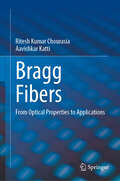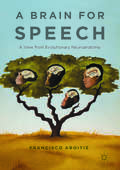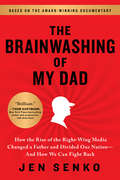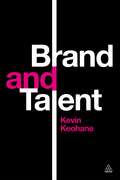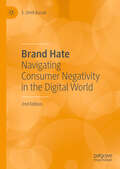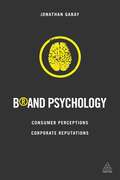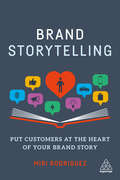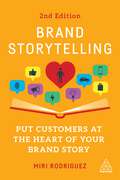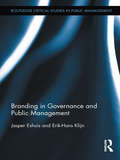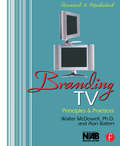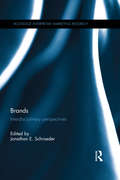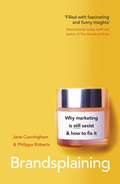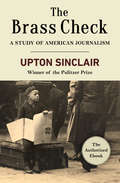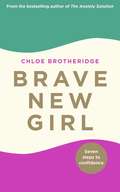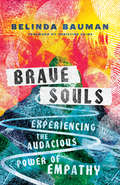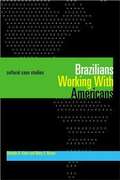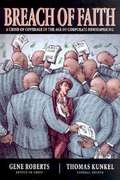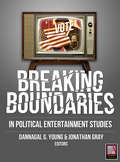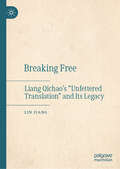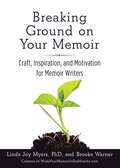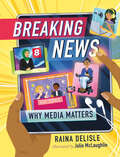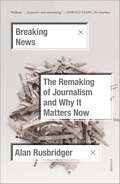- Table View
- List View
Bragg Fibers: From Optical Properties to Applications
by Ritesh Kumar Chourasia Aavishkar KattiThis book highlights the guiding mechanisms as well as the most current and important results in the field of innovative, bio-inspired Bragg fibers. While conventional optical fibers (COF) have several advantages over traditional waveguides, they also suffer from a number of disadvantages which are not present in Bragg fibers due to their minimal nonlinearities, lack of polarization or birefringence effect, lack of Fresnel reflections at the open fiber end, and absence of material or cladding losses. A natural platform for biological and chemical sensing, and with potential to boost communication systems' speed and bandwidth, the primary goal of this book is to apprise readers in academia and industry of properties of EM wave propagation in Bragg fibers with a defect layer. Their major applications in bio/chemical sensing, fuel adulteration sensing, high-temperature sensing, optical dual-channel inline filtering, optical de-multiplexers, optical couplers, and nonlinear soliton generation are presented in detail, along with comparisons of Bragg fibers with alternative structures and their relative pros and cons.
A Brain for Speech: A View from Evolutionary Neuroanatomy
by Francisco AboitizThis book discusses evolution of the human brain, the origin of speech and language. It covers past and present perspectives on the contentious issue of the acquisition of the language capacity. Divided into two parts, this insightful work covers several characteristics of the human brain including the language-specific network, the size of the human brain, its lateralization of functions and interhemispheric integration, in particular the phonological loop. Aboitiz argues that it is the phonological loop that allowed us to increase our vocal memory capacity and to generate a shared semantic space that gave rise to modern language. The second part examines the neuroanatomy of the monkey brain, vocal learning birds like parrots, emergent evidence of vocal learning capacities in mammals, mirror neurons, and the ecological and social context in which speech evolved in our early ancestors. This book's interdisciplinary topic will appeal to scholars of psychology, neuroscience, linguistics, biology and history.
The Brainwashing of My Dad: How the Rise of the Right-Wing Media Changed a Father and Divided Our Nation—And How We Can Fight Back
by Jen SenkoAfter her beloved dad got addicted to right-wing talk radio and Fox News, Jen Senko feared he would never be the same again…Frank Senko had always known how to have a good time. Despite growing up in a poverty-stricken family during the Depression and having to fight his way to middle-class status as an adult, he tended to look on the bright side. But after a job change forced Frank to begin a long car commute every day, his daughter Jen noticed changes in his personality and beliefs. Long hours on the road listening to talk radio commentators like Rush Limbaugh sucked her father into a suspicion-laden worldview dominated by conspiracy theories, fake news, and rants about the "coastal elite" and "libtards" trying to destroy America.Over the course of a few years, Jen's dad went from a nonpolitical, open-minded Democrat to a radical, angry, and intolerant right-wing devotee who became a stranger to those closest to him. As politics began to take precedence over everything else in her father's life, Jen was mystified. What happened to her dad? Was there anything she could do to help? And, most importantly, would he ever be his lovable self again? Jen began the search for answers, and found them... as well stories from countless other families like her own.Based on the award-winning documentary, The Brainwashing of My Dad uncovers the alarming right-wing strategy to wield the media as a weapon against our very democracy. Jen's story shows us how Fox News and other ultra-conservative media outlets are reshaping the way millions of Americans view the world, and encourages us to fight back.
Brand and Talent
by Kevin KeohaneMany books talk about brand, still more about talent, yet leading organizations are realising their identity as a service/product provider is virtually inseparable from their identity as a place that attracts, motivates and benefits from thriving talent. In Brand and Talent, author Kevin Keohane looks at how organisations can better communicate with people before, during and after their association with the enterprise. He presents a "joined up" approach that encompasses the needs of brand, marketing, human resources, corporate communications, internal communications and IT. He integrates academic and commercial evidence, as well as practical advice and includes case studies and interviews.
Brand Hate: Navigating Consumer Negativity in the Digital World
by S. Umit KucukThis book focuses on the concept of “brand hate” and consumer negativity in today’s digital markets. It explores the emotional detachment consumers generate against valued brands and how negative experiences affect their and other consumers' loyalty. It is almost impossible not to run into hateful language about companies and their brands in today’s digital consumption spaces. Consumer hostility and hate is not hidden and silent anymore but is now openly shared on many online anti-brand websites, consumer social networking sites, and complaint and review boards. The book defines consumer brand hate and discusses its dimensions, antecedents, and consequences as well as the semiotics and legality of such brand hate activities based on current brand dilution arguments. It describes the situations which lead to anti-branding and how consumers choose to express their dissatisfaction with a company on individual and social levels. This newly updated edition discusses recent research findings from brand hate literature with new cases and extended managerial analysis. Thus, the book provides strategic perspectives on how to handle such situations to achieve better functioning markets for scholars and practitioners in marketing, psychology, and consumer behavior.
Brand Psychology
by Jonathan GabayWhy do we trust some brands more than others? How important is integrity for a brand's survival? How can brand confidence be rebuilt during a crisis? Using both new and classic insights from social psychology, cognitive psychology and neuroscience, Brand Psychology reveals the hidden processes behind why certain brands command our loyalty, trust and - most importantly - disposable income. Reputation management authority Jonathan Gabay takes readers on a tour of the corporate, political, and personal brands whose understanding of consumer psychology has either built or broken them.Suitable for marketing, branding and PR professionals, reputation management specialists and students, Brand Psychology takes examples from e-cigarette legislation, the iPhone 5S's fingerprint ID technology, Barclays' branded bikes and the London 2012 Olympics, Miley Cyrus and the UK National Health Service's big data to reveal how to build a meaningful brand that resonates with the public.
Brand Storytelling: Put Customers at the Heart of Your Brand Story
by Miri RodriguezDespite understanding essential storytelling techniques, brands continue to explain how their product or service can help the customer, rather than showcasing how the customer's life has changed as a result of them. Brand Storytelling gets back to the heart of brand loyalty, consumer behaviour and engagement as a business strategy: using storytelling to trigger the emotions that humans are driven by. It provides a step by step guide to assess, dismantle and rebuild a brand story, shifting the brand from a 'hero' to 'sidekick' mentality, and positioning the customer as a key influencer to motivate the audience. Written by the award-winning storyteller Miri Rodriguez at Microsoft, Brand Storytelling is a clear, actionable guide that goes beyond content strategy, simplifying where to begin, how to benchmark success and ensuring a consistent brand voice throughout every department. Inspiring with interviews, advice and case studies from leading brands like Expedia, Coca Cola, McDonalds, Adobe and Google, it clarifies why machine-learning, AI and automation only tell one side of the story. Aligning an emotive connection with the customer's personal values, experiences and aspirations will enable brand leaders, employees and influencers to celebrate and strengthen brand engagement for long-term growth, rather than trying to win it.
Brand Storytelling: Put Customers at the Heart of Your Brand Story
by Miri RodriguezWritten by the award-winning storyteller Miri Rodriguez at Microsoft, this bestselling book gets back to the heart of brand loyalty, consumer behavior and engagement as a business strategy by using storytelling to trigger the emotions that humans are driven by.Despite understanding essential storytelling techniques, brands continue to explain how their product or service can help the customer, rather than showcasing how the customer's life has changed as a result of them. This second edition of Brand Storytelling contains new trends in storytelling, as well as expanding on story experience and employee experience. This book will explore the future of brand storytelling in a post pandemic era. New to this edition will also be a 'How to Guide' taking readers through each step of the design thinking process in order to prototype their stories.Brand Storytelling provides a step-by-step guide to assess, dismantle and rebuild a brand story, shifting the brand from a 'hero' to 'sidekick' mentality and positioning the customer as a key influencer to motivate the audience. Clarifying why machine-learning, AI and automation only tell one side of the story, this book will inspire you with cutting edge interviews and case studies from leading brands like Expedia, Coca Cola, McDonalds, Adobe and Google to tap into authentic brand loyalty and human connection.
Branding Brazil: Transforming Citizenship on Screen
by Leslie L. MarshBranding Brazil examines a panorama of contemporary cultural productions including film, television, photography, and alternative media to explore the transformation of citizenship in Brazil from 2003 to 2014. A utopian impulse drove the reproduction of Brazilian cultural identity for local and global consumption; cultural production sought social and economic profits, especially greater inclusion of previously marginalized people and places. Marsh asserts that three communicative strategies from branding–promising progress, cultivating buy-in, and resolving contradictions–are the most salient and recurrent practices of nation branding during this historic period. More recent political crises can be understood partly in terms of backlash against marked social and political changes introduced during the branding period. Branding Brazil takes a multi-faceted approach, weaving media studies with politics and cinema studies to reveal that more than a marketing term or project emanating from the state, branding was a cultural phenomenon.
Branding in Governance and Public Management (Routledge Critical Studies in Public Management)
by Jasper Eshuis E.H. KlijnPoliticians and public managers utilize branding to communicate with the public as well as to position themselves within the ever-present media now so central to political and administrative life. They must further contend with stakeholders holding contradictory opinions about the nature of a problem, the desirable solutions , and the values at stake. Branding is used as a strategy to manage perceptions, motivate stakeholders, communicate clear messages in the media, and position policies and projects. Brands have a unique ability to simplify such messages and motivate different actors to invest their energy in governance processes. Public administration scholars so far have however paid little attention to branding. This book provides a systematic analysis of branding as phenomenon in governance. It deals with the nature of public branding, its relation to existing theories in public administration, the way branding is used as a managerial strategy in governance processes, and the risks and limitations of branding. Branding in Public Governance and Management highlights the growing importance of public banding as a public management strategy to influence political events, decision-making processes and outcomes in governance processes.
Branding TV: Principles and Practices
by Walter McDowell Alan BattenIn an effort to halt increasing media competition and decreasing audience shares, Branding has become the new mantra among television station and network executives. Branding TV: Principles and Practices second edition goes beyond the jargon of branding to explain the essential principles underlying successful branding and offers many practical strategies to measure, build and manage television brand equity. For instructional purposes, the book pays particular attention to the local commercial TV station and its news franchise. Written by broadcast professionals with years of experience, this book shows how the notions of branding are no more prevalent than in the battle for dominance in local news. The practical suggestions in the book will help the savvy manager understand and take advantage of branding in their efforts to move their property to the forefront in the marketplace.
Brands: Interdisciplinary Perspectives (Routledge Interpretive Marketing Research)
by Jonathan E. SchroederBranding has emerged as a cornerstone of marketing practice and corporate strategy, as well as a central cultural practice. In this book, Jonathan Schroeder brings together a curated selection of the most influential and thought-provoking papers on brands and branding from Consumption Markets and Culture, accompanied by new contributions from leading brand scholars Giana Eckhardt, John F. Sherry, Jr., Sidney Levy and Morris Holbrook. Organised into four perspectives – cultural, corporate, consumer, critical - these papers are chosen to highlight the complexities of contemporary branding through leading consumer brands such as Disney, eBay, Guinness, McDonalds, Nike, and Starbucks. They address key topics such as celebrity branding, corporate branding, place branding, and retail branding and critique the complexities of contemporary brands to provide a rich trove of interdisciplinary research insights into the function of brands as ethical, ideological and political objects. This thought-provoking collection will be of interest to all scholars of marketing, consumer behaviour, anthropology and sociology, and anyone interested in the powerful roles brands play in consumer’s lives and cultural discourse.
Brandsplaining: Why Marketing is (Still) Sexist and How to Fix It
by Jane Cunningham Philippa Roberts'It's high time we expose and remedy the pseudo-feminist marketing malarkey holding women back under the guise of empowerment' Amanda Montell, author of Wordslut________________Brands profit by telling women who they are and how to be. Now they've discovered feminism and are hell bent on selling 'fempowerment' back to us. But behind the go-girl slogans and the viral hash-tags has anything really changed?In Brandsplaining, Jane Cunningham and Philippa Roberts expose the monumental gap that exists between the women that appear in the media around us and the women we really are. Their research reveals how our experiences, wants and needs - in all forms - are ignored and misrepresented by an industry that fails to understand us.They propose a radical solution to resolve this once and for all: an innovative framework for marketing that is fresh, exciting, and - at last - sexism-free.________________'If you think we've moved on from 'Good Girl' to 'Go Girl', think again!' Professor Gina Rippon, author of The Gendered Brain'An outrageously important book. Erudite, funny, and deeply engaging -- with no condescension or bullshit' Dr Aarathi Prasad, author of Like A Virgin'This book has the power to change the way we see the world' Sophie Devonshire, CEO, The Marketing Society and author of Superfast
The Brass Check: A Study of American Journalism (American Journalists Ser.)
by Upton SinclairA muckraking exposé of corruption in American journalism from the Pulitzer Prize-winning author of The Jungle Upton Sinclair dedicated his life to documenting the destructive force of unbridled capitalism. In this influential study, he takes on the effect of money and power on mass media, arguing that the newspapers, magazines, and wire services of the Progressive era formed "a class institution serving the rich and spurning the poor." In the early twentieth century, a "brass check" was a token purchased by brothel patrons. By drawing a comparison between journalists and prostitutes, Sinclair highlights the total control publishers such as William Randolph Hearst exerted over their empires. Reporters and editors were paid to service the financial and political interests of their bosses, even if that meant misrepresenting the facts or outright lying. Sinclair documents specific cases, including the Ludlow Massacre of 1914 and the Red Scare whipped up by Hearst's New York Journal and other newspapers, in which major news outlets ignored the truth in favor of tabloid sensationalism. Sinclair considered The Brass Check to be his most important and most dangerous book. Nearly a century later, his impassioned call for reform is timelier than ever. This ebook has been authorized by the estate of Upton Sinclair.
Brave New Girl: Seven Steps to Confidence
by Chloe BrotheridgeHarness your inner stength, confidence and stability with the essential guide from renowned hypnotherapist, host of The Calmer You podcast and bestselling author of The Anxiety SolutionIt's time to be the happiest, most confident and content version of yourself . . .'The only way to improve our confidence - in any area of life - is by pushing through our comfort zone . . . This straightforward guide will show you how' Evening Standard, Books to Read for Better Mental Health___________Confidence is not something we either have or don't have - it can be built, and this straightforward guide will show you how.Renowned clinical hypnotherapist and anxiety expert Chloe Brotheridge has helped hundreds of clients with anxiety and low self-confidence, and in this book will use her own stories, scientific research, and the experiences of other women to show you how to:· Feel more confident· Spend less time worrying and people-pleasing· Build self-belief· Reach your full potential· Assertively set boundaries for a happier, healthier youBrave New Girl reveals how everyone can follow their path to confidence.'A straightforward guide . . . she uses her own stories, scientific research and the experiences of other women to show her readers how to feel more confident' StylistAs seen in The Guardian, Mirror and Daily ExpressPraise for The Anxiety Solution:'Remarkable, pioneering, could change your life' Daily Mail
Brave Souls: Experiencing the Audacious Power of Empathy
by Belinda BaumanWhat if empathy could save us? Belinda Bauman was living a comfortable life as a wife, mother, and nonprofit leader—but her soul was checked out. Then she met Esperance. An assault survivor living in one of the poorest, most dangerous countries in the world, Esperance and other Congolese women shared their harrowing stories with Belinda. Their vulnerability set Belinda on a path of embracing empathy. If Esperance could love in the face of so much pain, maybe there is hope for the world too. From the top of Mount Kilimanjaro to the borders of war-torn Syria, Belinda takes readers along her journey to empathy. With cutting-edge neuroscience, biblical parables, and stories of brave women from across the globe, she offers readers direction for seeing others' perspectives, listening well, and redeeming conflict. She casts a vision for lives and communities transformed by everyday Christians practicing empathy as a spiritual discipline. Join Belinda on a journey to be brave—and see your world changed.
Brazilians Working With Americans/Brasileiros que trabalham com americanos: Cultural Case Studies/Estudos de casos culturais
by Kelm Orlando R. Risner Mary E.Brazilians Working With Americans presents ten short case studies that effectively illustrate many of the cultural factors that come into play when North American business professionals work in Brazil. The authors summarize each case and the aspects of culture it involves, and American and Brazilian executives comment on the cultural differences highlighted by that case. A list of topics and questions for discussion also help draw out the lessons of each business situation. To make the book equally useful to Brazilians and Americans (whether businesspeople or language students), the entire text is presented in both English and Portuguese.
Breach of Faith: A Crisis of Coverage in the Age of Corporate Newspapering
by Gene Roberts Thomas KunkelEnormous changes have taken place in the newspaper industry in recent years, from the birth of USA Today to the growth of Web-based media, introducing a host of questions about these changes' impact on average American newspapers in particular and on democracy as a whole. Newspaper editor Roberts (New York Times; Philadelphia Inquirer) and a group of journalists have been studying these questions and have released their findings in a pair of volumes. The first, Leaving Readers Behind (2001), focused on the economics of these changes. This second volume focuses on these changes' impact on the content of daily papers. While these eight essays touch on a variety of concerns-declining coverage of statehouse politics even as lobbyists grab more power, increasing coverage of business and sports, and the decrease of national and international coverage-there's an underlying despair that runs throughout them. Modern newspapers are better written and better looking, but they've lost their distinctive flavor, these writers say, that "essential local ingredient" that makes readers loyal. Worse, they avoid important national and most international stories; "a foreign story that doesn't involve bombs, natural disasters, or financial calamity" rarely makes it into the news. Focus group researchers argue that this trend mirrors readers' preferences, yet many of these essays insist that to maintain an informed electorate, newspapers need to refocus on hard news and let the accountants worry about the bottom line. J-school students and media policy makers will benefit greatly from this wise collection. Copyright 2002 Reed Business Information, Inc. -- From Publishers Weekly
Breaking Boundaries: In Political Entertainment Studies
by Dannagal G. Young Michael X. Delli Carpini Lauren Feldman Megan R. Hill Geoffrey Baym Heather Lamarre Larry Gross Roderick P. Hart Amber Day Jeffrey P. Jones R. Lance Holbert Paul R. Brewer Jonathan Gray Arlene Luck Lindsay HoffmanThis book brings together a collection of scholars whose work is leading the field of political entertainment studies, and yet it crosses methodological divides to do so, with quantitative and critical/cultural perspectives both represented. Indeed, each author worked as a part of a pair, addressing a similar topic as a colleague from across the divide. The result is a series of essays that add to and move beyond the state of political entertainment research--not only in content, but also in approach--by challenging readers to expand their thinking on these topics outside of the regular strictures. It begins with direct discussion of methodological divides in the field, as Michael Delli Carpini and Jeffrey P. Jones offer an essay, response, and further response. Following this initial, explicit tackling of methodology and what is at stake, Geoffrey Baym and Lindsay Hoffman each examine partisan language and interviews in The Daily Show with Jon Stewart and The Colbert Report, respectively; Lauren Feldman and Paul Brewer examine satirical treatments of science; Amber Day and Heather LaMarre address the importance of Stephen Colbert's Super PAC; Dannagal G. Young and Roderick Hart discuss The Daily Show's treatment of political participation, citizenship, and social protest; and finally, Megan Hill and R. Lance Holbert each wrestle with developing a normative approach to political satire. Read what scholars think!
Breaking Free: Liang Qichao’s “Unfettered Translation” and Its Legacy
by Lin JiangThis book deeply examines the definition, formation, translation purpose, stylistic features, and modernity connotation of Liang’s “unfettered translation.” The book on Liang Qichao and his “unfettered translation” is the first of its kind in academia. This translation strategy, first adopted by Liang, played a crucial role in introducing Western learning and influencing late Qing Dynasty translators. Reflecting Liang’s political agenda, it aims to save the country and enlighten the people, promoting societal modernization and cultural exchange. The book offers Western readers insights into Liang Qichao’s translation and its impact on modern Chinese culture.
Breaking Ground on Your Memoir: Craft, Inspiration, and Motivation for Memoir Writers
by Brooke Warner Linda Joy MyersIn Breaking Ground on Your Memoir, Linda Joy Myers (President of the National Association of Memoir Writers) and Brooke Warner (Publisher of She Writes Press) present from the ground up—from basic to advanced—the craft and skills memoirists can draw upon to write a powerful and moving story, as well as inspiration to write, finish, and polish their own story. Full of rich insights and practical advice and strategies, Breaking Ground on Your Memoir offers all the tools writers need to write a powerful, publishable memoir. In this book you will discover: • how to get focused on what your memoir is about—your themes. • how to build the structure of your story. • techniques to make your memoir come alive. • the secrets of craft: how to write a great scene, colorful and memorable descriptions, narration, and flashback. • how to connect with your reader using through-threads and takeaway so they&’ll keep turning the pages, and learn something about their own lives by reading your book. Visit the authors online at WriteYourMemoirInSixMonths.com.
Breaking News: Why Media Matters (Orca Think #10)
by Raina DelisleKey Selling Points Kids are spending more time on the internet and social media, where they may be exposed to fake news, clickbait, misinformation and disinformation. It's important for them to learn how to become critical news consumers. The media industry is at a critical juncture. After years of being battered by the internet and social media, new business models are starting to emerge. But much damage has been done and trust in the media has dropped to an all-time low. Breaking News is full of tips on how kids can get involved in the media industry and share their thoughts, including writing letters to the editor, taking journalism classes, joining the school paper, getting a paper route and even starting their own media outlet. The book includes stories from journalists, including kids, that will inspire readers to get involved in the industry. The author is an award-winning journalist who worked for daily newspapers, TV news programs and independent online publications across Canada.
Breaking News: A Stunning and Memorable Account of Reporting from Some of the Most Dangerous Places in the World
by Martin FletcherMartin Fletcher doesn't claim to be a hero. Yet he didn't flinch, either. During three decades covering wars, revolutions, and natural disasters, Fletcher worked his way from news agency cameraman to top network correspondent, facing down his own fears while facing up to mass killers, warlords, and murderers. With humor and elegance, Fletcher describes his growth from clueless adventurer to grizzled veteran of the world's battlefields. His working philosophy of "Get in, get close, get out, get a drink," put him repeatedly in harm's way, but he never lost sight of why he did it. In a world obsessed with celebrities, leaders, and wealth, Fletcher took a different route: he focused on those left behind, those paying the price. He answers the question: Why should we care? These extraordinary, real-life adventure stories each examine different dilemmas facing a foreign correspondent. Can you eat the food of a warlord, who stole it from the starving? Do you listen politely to a terrorist threatening to blow up your children? Do you ask the tough questions of a Khmer Rouge killer, knowing he is your only ticket out of the Cambodian jungle? And above all, how do you stay sane faced with so much pain?
Breaking News: The Remaking of Journalism and Why It Matters Now
by Alan RusbridgerAn urgent account of the revolution that has upended the news business, written by one of the most accomplished journalists of our timeTechnology has radically altered the news landscape. Once-powerful newspapers have lost their clout or been purchased by owners with particular agendas. Algorithms select which stories we see. The Internet allows consequential revelations, closely guarded secrets, and dangerous misinformation to spread at the speed of a click.In Breaking News, Alan Rusbridger demonstrates how these decisive shifts have occurred, and what they mean for the future of democracy. In the twenty years he spent editing The Guardian, Rusbridger managed the transformation of the progressive British daily into the most visited serious English-language newspaper site in the world. He oversaw an extraordinary run of world-shaking scoops, including the exposure of phone hacking by London tabloids, the Wikileaks release of U.S.diplomatic cables, and later the revelation of Edward Snowden’s National Security Agency files. At the same time, Rusbridger helped The Guardian become a pioneer in Internet journalism, stressing free access and robust interactions with readers. Here, Rusbridger vividly observes the media’s transformation from close range while also offering a vital assessment of the risks and rewards of practicing journalism in a high-impact, high-stress time.
Breaking News: How to Tell What's Real From What's Rubbish
by Nick SheridanThe perfect gift this Christmas – a funny, practical and ever-so timely guide to the NEWS for 8–12-year-olds. Find out how to understand and navigate 24/7 news, how to spot the facts from the fake . . . and what to do if the news becomes overwhelming. Perfect for fans of Matthew Syed&’s You Are Awesome and Rashmi Sirdeshpande's Dosh. It&’s never been easier to access the news; TV, radio, billboards, newspapers and endlessly buzzing on to the screens in our pockets. But with more and more news available, it&’s hard to know what to trust. Where do stories come from? What&’s real news and what&’s fake? And what role does social media play in all of this? Insightful, hands-on, essential and reassuring, Breaking News will help children navigate the peaks and pitfalls of our modern day news cycle, through laugh-out-loud text, amusing illustration and interactive activities. Praise for Breaking News:'Newsflash: I loved it.&’ – Eoin Colfer, million-copy selling author of ARTEMIS FOWL&‘A perfect read for any budding young journalists out there.&’ – Konnie Huq, TV presenter and author of the COOKIE! series&‘Jam-packed with fascinating facts, this is a fantastically funny and much-needed guide to navigating the news.&’ – Rashmi Sirdeshpande, author of DOSH
